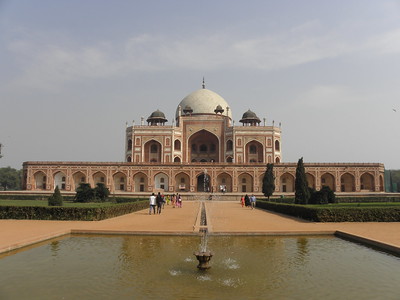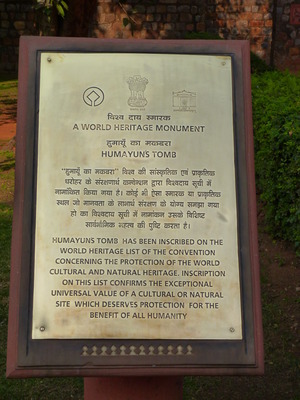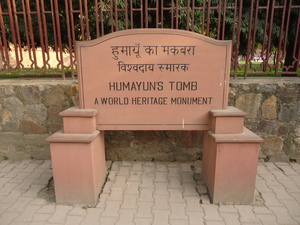Humayun's Tomb

Humayun's Tomb, Delhi is a monumental Mughal garden-tomb complex.
This dynastic mausoleum was built in 1570 for Humayun, the second Mughal Emperor of India, and now contains about 150 graves of ruling family members. It uses mainly red sandstone, with white and black marble inlays. It is a landmark in the development of Mughal architecture, as it introduced a Persian/Central Asian style Charbagh garden with pools joined by channels to the funerary monument.
Community Perspective: “The contrast between the city and the peaceful garden and the monument was truly stunning”. Carlo has also covered two of the 'lesser' tombs at the complex and provides some pointers for a longer visit than the usual 45 minutes.
Map of Humayun's Tomb
Community Reviews
Alikander99

I'm torn with this review. On one hand humayun's tomb has a privileged place in mughal history as the first of the monumental musoleums that would end with the iconic Taj mahal. On the other hand I feel the techniques that would make the Taj mahal the masterpiece it is, hadn't yet shone through. The structure lacks the striking verticality of later mughal structures and the decoration with pietradura had yet to be perfected. This leaves the mausoleum rather plain, though the alternation of marble and sandstone somewhat lessens this.
On another note it's refreshingly empty compared with the utterly overcrowded Taj mahal and it includes a number of lesser mausoleums which are indeed very interesting and some utterly devoid of tourists. Such as the striking tomb of Isa Khan Niazi (photo), a noble from the courts of Sher Shah Suri, the man who gave the mughals a run for their money.
Carlo Sarion
Philippines/New Zealand - 08-Jan-24 -

My visit to Delhi in Dec 2023 was part of my mission of retracing my steps back in 2013, when I first travelled to India and missed visiting Humayun's Tomb and Qutb Minar. That was the time when I didn't care much about UNESCO World Heritage Sites, and my travel companion had a set itinerary I didn't want to deviate from. This time, I made sure that I would visit these sites.
The inscribed property refers to a complex comprising one main tomb (Humayun's tomb itself) and several other smaller tombs. Note that this complex of tombs is just one of the many tombs that are scattered across Nizamuddin neighbourhood and the greater Delhi. As a friend would call it, Delhi is both a metropolis and a massive graveyard.
1. Humayun's Tomb
We arrived at the ticket office around 2 pm, which was about the same time the school kids were finishing their visit to the tomb. We went straight to the Western Gate, passing both Bu Halima's Tomb and Garden and Isa Khan's Tomb and Mosque on the way to the main tomb. After taking a photo of the UNESCO plaque, we passed through the Western Gate and walked towards Humayun's tomb. The mausoleum sits on top of a high platform, giving the already prominent mausoleum a more "superior" status over the entire complex. We climbed the stairs and explored the mausoleum. We saw people "testing" the acoustics of the mausoleum walls, while others were busy taking their perfect Instagram photos. We then went to the eastern side of the mausoleum, sat on a bench under the shade, and admired the entire structure.
I see the symmetry, geometry, and lines within the mausoleum as indicative of the intricate architectural and decorative features of the building. The buildings in the complex represent one of the early examples of Mughal architecture, which may also serve as a good benchmark to see the differences in and perhaps the evolution of Mughal architecture over time, particularly when compared with Taj Mahal, Fatehpur Sikri, and the forts in Lahore, Agra, and Delhi. I also agree with the previous reviews: this site is a perfect place to find some respite from the overwhelming chaos just outside of the gate. The peace is punctuated by the noise from the nearby Hazrat Nizamuddin train station, however. Additionally, the gardens are well-maintained as evidenced by the number of workers tending to the plants amidst the crowd of tourists.
2. Barber's tomb
The bench where we sat and rested was right in front of the Barber's Tomb, a cute mausoleum made of grey and red sandstone. The faded hues of the building made it look unkempt compared to the main tomb, though I like how the blue colour of the chhatri domes breaks the monotony of dominant grey and red. Contrary to what the name of this tomb suggests, the identity of the person interred here remains unknown.
3. Isa Khan's tomb and mosque
After hanging around the main tomb for about 45 minutes, we decided to head back to the Western Gate. We were quite ready to leave the site and didn't even think of checking out Isa Khan's tomb and mosque. Thankfully, my partner insisted on entering the enclosure and boy was I happy we did. If it is details and colours that you are looking for, Isa Khan's tomb would offer you just that, though the architecture of the structure is said to be more of Lodhi style than purely Mughal. The colours of the domes of the canopies and the highly ornamented ceilings are noteworthy. There were several cenotaphs inside the tomb, which were illuminated by the sunlight that came through the lattice screens. Don't forget to check the small mosque on the western side of the tomb.
I'd also like to note that in 2016, the Archaeological Survey of India (ASI) and other involved agencies put forward a minor boundary modification to include some tombs within the adjacent Sunder Nursery, such as Sundarwala Mahal, Sundarwala Burj, and Lakkarwala Burj. Sunder Nursery was being restored at the time of inclusion as part of the wider Nizamuddin Urban Renewal Initiative. The "heritage park" finally opened in February 2018. While I did not go to Sunder Nursery to check the other tombs, I am certain that it is worth a visit. In this case, it is best to allot about 3 hours to visit this site, both to unwind in the gardens surrounding the main tomb and to check the smaller tombs in Sunder Nursery.
Kai Chongloi
This monument is the best site to see in Delhi. I went there in 2010 and was surprised to see that it was totally different from other sites in Delhi. The surrounding was clean, calm and peaceful. No hawkers, conmen, scammers etc. And the monument was magnificient. I highly recommend this site to anyone visiting Delhi.
Clyde

I visited this WHS in January 2012. This site is unique as it was the stepping stone to build the Taj Mahal. The architectural symmetry of the tomb and its gardens can be clearly seen also in this site.
Els Slots

Humayun's Tomb was the last of Delhi's WHS that I visited. It is undoubtedly the most picturesque of all of the sites, with its perfect shapes. It is easy to see how it has influenced the Taj Mahal. But I have not become a big fan of Mughal architecture here in Delhi: the buildings were constructed to impress, but lack fine details (or maybe these have disappeared during the ages, the glazed tiles are very few now).
My visit to the site lasted a mere 45 minutes, and I cannot see how I could have spent more time here (although part of the complex is fenced off at the moment). The "park" could use some more water, to make the lawns look green and fresh, and also to fill up the little canals and pools that surround the Tomb.
However, as Rob Wilson already stated below, the state of the site has improved a lot over the last few years. There's an exhibition on site where you can see "before" and "after" photos.
Christer Sundberg

Bustling and busy Dehli can prove to be quite a challenge for the first time visitor so entering the gates of Humayun’s Tomb felt like quite a nice relief from persistent rickshaw-drivers, touts, beggars, snake charmers and other annoying elements you are confronted with. It’s a cultural shock that any European have to go through but after some weeks of travel on the Indian continent I promise that you will see them as part of a wonderful and massively colourful society that draws you back for another visit.
Humayum’s Tomb was built by the grief-stricken wife of emperor Humayun in 1565. It took nine years to complete the tomb and it is said to be a landmark in the evolution of early Mughal architecture and legend tells that it’s been a model for the mighty Taj Mahal in Agra.
I visited Humayum’s Tomb on an early December morning when only a few visitors had entered the site and the contrast between the city and the peaceful garden and the monument was truly stunning. With several adjacent palaces and tombs, make sure you take at least some 2-3 hours to fully enjoy this wonderful place.
Siddharth Dasgupta
Haunting. Mesmerizing. Unforgettable. The mythical aura surrounding Humayun's Tomb became a part of my soul the moment I laid my eyes on it, in January of 2005. That beautiful foggy winter morning in New Delhi is indelibly entrenched in my heart... as the day I came across perfection.
Rob Wilson
I have visited the tomb twice. Once in 2002 when it was a fairly horrific state of repair. I returned last summer and am pleased to say that the ASI have done a magnificent job of restoring this wonderful old tomb. It is surely one of the most evocative tombs on Earth. It provides a moments peace from the madness of Delhi and is even more interesting if you know about the extraordinary life of Humayoun himself.
Community Rating
- : Thomas Kunz BH Bag-packer-family Travelure Roxfts Sofia84
- : Chenboada Giulio25 Fede1203
- : Philipp Peterer Wojciech Fedoruk Craig Harder Nan Svein Elias Alexander Parsons Zoë Sheng Daniel Gabi Alexander Lehmann Kevin McFarland Hurrvinek Aspasia Juropa Alikander99 Mihai Dascalu Akacesfan Lembu Javier
- : Els Slots Frederik Dawson Tony H. Roman Raab Martina Rúčková Clyde Randi Thomsen Xiquinho Silva Stanislaw Warwas Ge zhang Ralf Regele YAO WEI Luke LOU Shandos Cleaver Lichia Tarquinio_Superbo Hanming J_neveryes Campmany
- : Solivagant Joyce van Soest Mikko Gary Arndt Chalamphol Therakul Neil McPaul Riccardo Quaranta Tevity Lucio Gorla Carlo Sarion Travtasy Richard Stone Dorejd Priyaranjan Mohapatra Gordon Mitchell Laurine Jon Opol BMuramatsu
- : Bernard Joseph Esposo Guerrero David Marton Ludvan Adiaro18
- : Philipp Leu Richardleesa Adrian Turtschi
Site Info
Site History
1993 Inscribed
Site Links
Unesco Website
Official Website
Related
In the News
Humayun's Tomb may stand the risk of losing the World Heritage Status awarded to it by UNESCO. A proposed tunnel road project which is expected to come up near the tomb for the 2010 Common Wealth games may be the reason behind the risk, and already a bone of contention for the conservationists who have opposed its construction. (2007.05.27)
Connections
The site has 24 connections
Art and Architecture
Constructions
Geography
History
Human Activity
Individual People
Timeline
Trivia
Visiting conditions
WHS Hotspots
WHS Names
WHS on Other Lists
World Heritage Process
Visitors
361 Community Members have visited.
The Plaque
 (photo by Clyde)
(photo by Clyde) (photo by Jarek)
(photo by Jarek)